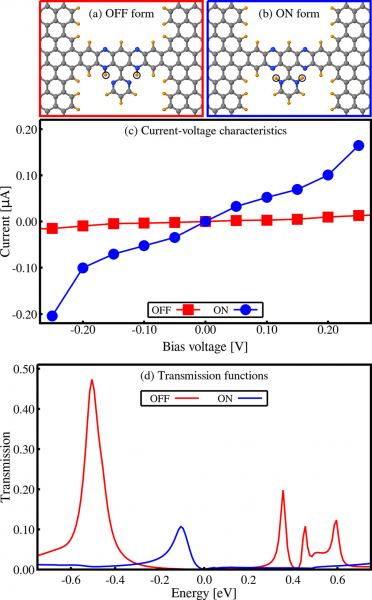A molecular transistor controlled through proton transfer
In this work, the authors have used density functional theory methods and the non-equilibrium Green´s function formalism to investigate the possibility of implementing a molecular transistor based on a graphene-molecule junction using a reversible intramolecular proton transfer reaction to control the conductance state of the molecule in the junction.
The ongoing trend in device miniaturization is pushing current semiconductor technologies to their efficiency limit. With the decrease in size, electronic devices are prone to suffer from increasing leakage currents and undesired thermal effects due to high power densities. In search of alternatives to overcome these limitations, the idea of using single molecules to build electronic components has attracted great interest.
In this context, Weckbecker et al. have explored the possibility of using a molecule‒graphene junction where the molecular bridge features two differently conducting states (ON/OFF) that can be interconverted through a proton transfer process to implement a molecular transistor. For this, they have characterized the ON/OFF switching process, which has been shown to be intrinsic to the molecular bridge and robust with respect to changes of the type of the termination of the graphene leads. Furthermore, the researchers have shown that the ON/OFF state of the molecular bridge can be controlled using an external electrostatic gate field, which enables the possibility of using this molecular junction as a molecular field effect transistor. Finally, they have also verified that the mechanism is robust with respect to structural changes of the molecular bridge, paving the way for the optimization of the ON/OFF conductance ratio and the gate field strength needed to trigger the intramolecular proton transfer process.
All in all, this work has shown that molecular nanojunctions exhibiting an intramolecular proton transfer mechanism can be used to realize a molecular transistor.

Figure: Molecule−graphene nanojunction investigated in this work with the molecular bridge in the (a) low conductance (OFF) and (b) high conductance (ON) tautomeric, (c) the corresponding current−voltage characteristics and (d) zero-bias transmission functions of the junction in these two forms. The black circles in (a) and (b) indicate the hydrogen atoms involved in the proton transfer process.



